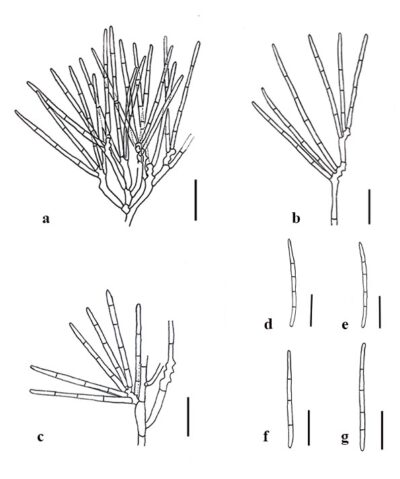Fungalpedia – Note 170, Minteriella
Minteriella Heredia, R.F. Castañeda & R.M. Arias
Citation when using this entry: Madagammana et al. 2024 (in prep) – Fungalpedia, genera described in 2012.
Index Fungorum, Facesoffungi, MycoBank, GenBank, Fig. 1.
Classification: Pezizomycotina, Ascomycota, Fungi
Minteriella is an asexual genus introduced by Heredia et al. (2012), based on morphology, and typified by M. cenotigena. Minteriella is characterized by scattered, synnematous conidiomata and superficial and immersed mycelia. Conidiophores are differentiated, septate, brown, simple, or branched, and the conidiomata are polyblastic, discrete, and indeterminate with sympodial proliferations. The conidiogenous loci are flat, unthickened, apical, and intercalary. Conidia exhibit schizolytic conidial secession, with solitary, acropleurogenous, multiseptate, cylindrical to broad filiform, subhyaline or hyaline, with a smooth wall (Heredia et al. 2012).
Minteriella resembles Chikaneea, Cylindrosympodium, Pleurotheciopsis, Polyscytalum, Subulispora, Sympodioplanus, and Thedgonia from their conidial ontogeny (Heredia et al. 2012). However, this genus differs from Chikaneea, Pleurotheciopsis, and Polyscytalum by synnematal conidiomata and conidial formation in unbranched and acropetal chains. Thedgonia exhibits unpigmented conidiophores, conidiogenous cells, and conidia that differ from Minteriella (Heredia et al. 2012). This genus is listed under Ascomycota genera incertae sedis (Wijayawardene et al. 2022), and the phylogenetic position remains unresolved due to the lack of sequence data. Currently, only one species is listed in Index Fungorum (2023), and it was collected on the decaying bark of an unidentified plant submerged in a sinkhole in Mexico (Heredia et al. 2012).
Type species: Minteriella cenotigena Heredia, R.F. Castañeda & R.M Arias.
Figure 1 – Minteriella cenotigena (XAL CB897, holotype). a-c Conidiogenous cells and conidia. d-g. Conidia. Scale bars: a-g = 10 μm. Redrawn from Heredia et al. (2012).
References
Entry by
Ashani D. Madagammana, Center of Excellence in Fungal Research, Mae Fah Luang University, Chiang Rai, 57100, Thailand; School of Science, Mae Fah Luang University, Chiang Rai, 57100, Thailand.
(Edited by Chitrabhanu S. Bhunjun, Kevin D. Hyde, Subodini N. Wijesinghe, Samaneh Chaharmiri-Dokhaharani, & Achala R. Rathnayaka)
Published online 9 January 2024
